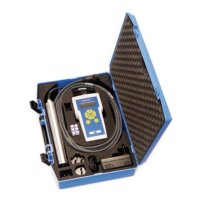19
Start Up
4.7 Calibration
For turbidity measurement, a standard curve C-TU is already stored in the probe.
Calibration is not required.
However, for solids measurement, calibration is required in order to set the rough
measurement signals to a calibrated display (refer to section 5.1, page 23). A precise
solids measurement is not possible without calibration. There are four calibration curves
available: C-DS1, C-DS2, C-DS3, C-DS4. These curves can be allocated to the individual
measurement points.
4.8 Defining the measurement points
4.8.1 Overview of calibration curves
• C-TU = Turbidity curve (standard curve)
• C-DS1 = solids curve 1 (calibration curve)
• C-DS2 = solids curve 2 (calibration curve)
• C-DS3 = solids curve 3 (calibration curve)
• C-DS4 = solids curve 4 (calibration curve)
4.8.2 Measurements
4.8.2.1 Practical example for solids measurement
Note: The type and composition of the solid particles of a medium can differ greatly. For this reason,
it is not possible to define a general standard, and different measurement media must be calibrated
specifically in each case.
For the solids measurement, calibration is required. There are four curves available:
C-DS1, C-DS2, C-DS3, C-DS4. Each curve can be assigned to any measurement point.
In the example, curve C-DS1 is selected.
1. Connect the probe to the instrument.
2. To switch on the instrument, press
ENTER/ON for 2 seconds.
Select calibration curve
3. Select
MENU, confirm with ENTER/ON.
4. Select
CALIBRATE, confirm with ENTER/ON.
5. Select
CURVE C-TU and confirm withENTER/ON.
Note: Curve C-TU is the default setting.
6. Select calibration curve C-DS1 with the navigation keys UP/DOWN and confirm
with
ENTER/ON.
The instrument reads the probe data and info text appears on the display.

